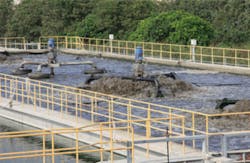New research from Frost & Sullivan’s Analysis of the North American Submersible Pumps Market finds the submersible pumps market earned revenues of $264.5 million in 2011 and estimates this to reach $364.7 million in 2018.
This research showcases key market metrics, expected growth over the next seven years, and market drivers anticipated to influence strategic activities of submersible pumps market suppliers.
"There are a number of factors currently affecting the general market—economic uncertainties, regulatory shifts, and so on," said Frost & Sullivan Research Analyst Anudeep Yegireddi, in a prepared statement. "Add to that the maturity of the technology and overall industry, and it is a challenging scenario that is not offering tremendous growth."
Water & Wastewater Market As Key Driver
While the total market is expected to experience minimal growth through the forecast period, there are some areas that Frost & Sullivan said it sees as potential bright spots. An example is the water and wastewater industry, one of the largest groups of submersible pumps users. Expected growth in the consumption of and demand for fresh water as well as the dire need for water system infrastructure improvements are anticipated drivers toward stronger than average market growth. As municipal water and wastewater applications continue to grow, the need for submersible pumps increases.
Surface, raw water and the pre-treatment of water and wastewater require a purification process that necessitates a submersible pump to accurately treat the water with chemicals. As the population continues to grow, the need to develop more treatment facilities is expected to increase. In addition, the demand for submersible pumps is likely to drive the market in water and wastewater applications because of its unique design wherein both the pump and motor are submerged in water to handle large solids or to grind solids to smaller sizes.
Construction, one of the major submersible pumps end-user verticals, has been slow to recover from the economic recession. While the global crisis of 2009 has faded, the construction industry, especially the residential building market, is still greatly affected. This lag is expected to continue until the mortgage problems inherent in banks resolve themselves, Frost & Sullivan reports.
“The construction market has finally stabilized a bit," said Yegireddi. "Forecasts are cautiously optimistic for growth, albeit nominal, in this industry. This trend is expected to bode well for submersible pump demand."
Among competitive factors, the service play continues to gain importance, as with other pump types. Service is becoming the critical factor for large institutional end-users—without regular maintenance, they risk downtime that would result in a significant drop in productivity, lower profitability, and high-energy consumption. Continuous process industries such as oil and gas, chemicals, and pulp and paper, as well as vital industries such as power generation, cannot afford downtime, Frost & Sullivan says. The presence of local customer service personnel aids in reducing service lead times and ensures high uptime. This is a major reason that end-users prefer to associate with manufacturers that have a local presence.
In all, Frost & Sullivan concludes that North America is a mature market for submersible pumps, a scenario that challenges suppliers to sharpen their strategic thinking and expand their toolbox of tactics to grow beyond today's market averages. With 2012 growth estimated at approximately 3 percent, submersible pumps manufacturers must find the dynamic seams in the market that can provide growth that is more in line with their corporate objectives.
For more information on Analysis of the North American Submersible Pumps Market, click here.


